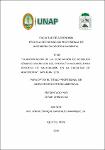| dc.contributor.advisor | Bardales Manrique, Jorge Enrique | |
| dc.contributor.author | Chino Díaz, Cesar | |
| dc.date.accessioned | 2020-08-27T14:50:52Z | |
| dc.date.available | 2020-08-27T14:50:52Z | |
| dc.date.issued | 2020 | |
| dc.identifier.uri | http://repositorio.unapiquitos.edu.pe/handle/20.500.12737/6835 | |
| dc.description.abstract | El fin del trabajo, fue cuantificar la generación de excretas de la crianza de vacunos
para su proceso de valoración y sea aprovechado el material orgánico en la
elaboración del compostaje, realizándose el monitoreo de los parámetros
fisicoquímicos y microbiológicos para determinar la calidad o efectividad de la
utilización de las excretas. El trabajo se ejecutó en el Taller de Vacunos de la Unap.
La investigación fue de tipo observacional, prospectivo, transversal; los datos fueron
recogidos en una sola intervención y es univariado porque describe medidas en la
unidad de evaluación en observación. El universo fue de 17 animales que posee el
proyecto vacuno en diferentes etapas de crecimiento. Se aplicó un muestreo no
probabilístico; es expresar, un muestreo por conveniencia, esto fundado que por la
dimensión del universo es conveniente evaluar a todos los animales que conforman
este proyecto; es decir, el 100% de la población del proyecto.
Los resultados obtenidos desde el peso inicial de la mezcla que entró al proceso de
compostaje (excretas vacuno, forraje verde y aserrín) con 612.10 Kg a los 58 días se
obtiene un peso final de 448Kg, con una reducción en el peso de 27%. Se consiguió
una producción de excreta media por semana de 45kg, con una Generación Per
Cápita por animal de 2.66kg/día, y una proyección diaria de generación de 0.0454
Tn/día, 1.36 Tn/mes y 16.27 Tn/año. En base al resultado obtenido se acepta la
hipótesis de la investigación ya que la generación de excretas nos permitió obtener
una producción de compost en el proyecto centro de acopio facultad de Agronomía. | es_PE |
| dc.description.abstract | The objective of the present investigation was to quantify the generation of excreta of
the raising of cattle for its process of valuation and the organic matter is used through
the elaboration of the composting, being carried out the monitoring of the
physicochemical and microbiological parameters to determine the quality or
effectiveness of the use of excreta. The research was carried out in the Vaccine
Project of the National University of the Peruvian Amazon.
The research was observational, prospective, transversal; Because the data reflects
the natural evolution of the events, the data was collected in a single intervention and
is univariate because it describes parameters in the study population from a sample.
The population consisted of 17 animals that own the beef project at different stages
of growth. A non-probabilistic sampling was applied; that is to say, a sampling for
convenience, based on the size of the population, it is convenient to evaluate all the
animals that make up this project; that is, 100% of the project population.
The results obtained from the initial weight of the mixture that entered the composting
process (beef excreta, green fodder and sawdust) with 612.10 Kg after 58 days a final
weight of 448 kg is obtained, with a reduction in weight of 27%. An average excreta
generation per week of 45kg was obtained, with a Per Capita Generation per animal
of 2.66kg / day, and a daily generation projection of 0.0454 tons / day, 1.36 tons /
month and 16.27 tons / year. Based on the result obtained, the research hypothesis
is accepted since the generation of excreta allowed us to obtain a compost production
in the Agronomy Faculty Collection Center project. | en_US |
| dc.description.uri | Tesis | es_PE |
| dc.format | application/pdf | es_PE |
| dc.language.iso | spa | es_PE |
| dc.publisher | Universidad Nacional de la Amazonía Peruana | es_PE |
| dc.rights | info:eu-repo/semantics/openAccess | es_PE |
| dc.rights | Attribution-NonCommercial-NoDerivs 3.0 United States | * |
| dc.rights.uri | http://creativecommons.org/licenses/by-nc-nd/3.0/us/ | * |
| dc.source | Universidad Nacional de la Amazonía Peruana | es_PE |
| dc.source | Repositorio institucional - UNAP | es_PE |
| dc.subject | Excreta | es_PE |
| dc.subject | Ganado vacuno | es_PE |
| dc.subject | Residuos sólidos | es_PE |
| dc.subject | Compost | es_PE |
| dc.subject | Valor económico | es_PE |
| dc.title | Cuantificación de la generación de residuos sólidos orgánicos del proyecto vacunos, para proceso de valoración. en la Facultad de Agronomía”. San Juan. 2019 | es_PE |
| dc.type | info:eu-repo/semantics/bachelorThesis | es_PE |
| thesis.degree.discipline | Ingeniería en Gestión Ambiental | es_PE |
| thesis.degree.grantor | Universidad Nacional de la Amazonía Peruana. Facultad de Agronomía | es_PE |
| thesis.degree.level | Título Profesional | es_PE |
| thesis.degree.name | Ingeniero(a) en Gestión Ambiental | es_PE |
| thesis.degree.program | Presencial | es_PE |
| dc.subject.ocde | Agricultura | es_PE |
| dc.subject.ocde | http://purl.org/pe-repo/ocde/ford#4.01.01 | es_PE |


